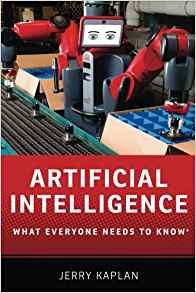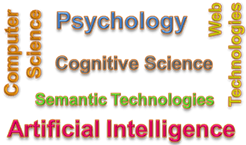Machine Reasoning and your AI Journey
Where to begin? What to expect? How to really benefit?
Branches of AI
AI is coming of age...
Machine Learning, Deep Learning, Cognitive Computing,
Robotic Process Automation (RPA), Natural Language Processing (NLP),
Machine Perception, Predictive APIs, Image Recognition,
Speech Recognition, Virtual Agent, Intelligent Assistant,
Personal Advisor, Chatbot, Semantic Search... anything missing?
MACHINE REASONING!
If you've never heard about this term before,
just read on and you will soon understand the concept and the
benefits of the adoption of this AI technology by your organisation.
Machine Reasoning basics: Using Human 'Know-how' to Teach the Machine
Machine Reasoning (MR) systems generate conclusions from previously acquired
knowledge by applying logical techniques like deduction and induction.
Computer Scientist and Futurist Jerry Kaplan describes a reasoning system as "a concept
that deconstructs tasks requiring expertise, into two components:
1 - 'a knowledge base' - a collection of facts, rules
and relationships about a specific domain of interest, represented in a symbolic form
that a computer can understand
2 - a general-purpose 'inference engine' that describes how to manipulate
and combine these symbols."
As one of the biggest advantages of reasoning systems, Kaplan states that, as they are
based on facts and rules, the operation and performance of those kinds of systems
can be modified more easily since new facts and knowledge can be incorporated over time.
In this process, reasoning systems are taught by "knowledge engineers" who interview
expert practitioners and "incrementally incorporate their expertise into computer
programs". In this way a common language of concepts and their inter-relationships is
constructed and contained in an 'ontology'. And thus, the machine has a language it
can work with and combine to solve multiple problems on its own.
This structure and approach also makes it much more convenient to explain the
reasoning performed by the system.
What do today's Machine Reasoning Systems Look Like?
Today's machine reasoning systems feature four components:
- Learning:
A young child captures what it needs to learn from parents, teachers, other children or anyone else by using its 'sensors' like ears and eyes. For a machine, this can be done by individuals or groups of experts teaching the machine bits of their contextual 'know-how', insight and understanding - including the what, where, when and why (codified with assistance from knowledge engineers, initially).
This is what the machine uses subsequently to reason as it performs its tasks and explain its recommendations. Thus, the AI learns best practices and reasoning from its donor experts. - Semantic Graph:
AI understands the domains in which it is to operate by creating a codified semantic map of all the concepts in its world, their inter-relationships and attributes, and the values associated with those attributes. This 'Graph' of taught knowledge is held within a special data store called a Triple Store. The machine uses the contents of the store to understand the meaning of concepts and then perform its semantic reasoning.
Example: I know that Brasil has a connection to Portugal. And Portugal is connected to the EU. And the EU is connected to 28 countries. And its HQ is in this buiding in a city called Brussels where moules et frites is a popular dish. This is a semantic graph of part of the world that we know - part of our memory. - Reasoning Engine:
The engine is the core service that puts everything together and delivers a solution to a certain problem. It accesses everything it needs know from its Triple Store and finds the correct solution to a specific problem on its own, step by step, based on the knowledge it has access to. - Adaptive Problem Solving:
Adaptive Problem Solving, also known as Machine Reasoning (MR), is the ability to dynamically react to change and by doing this, re-using existing knowledge for new and unknown problems. With MR, problems are solved in ambiguous and changing environments. The AI dynamically reacts to an ever-changing context, selecting the best course of action. Thus, MR forms the basis for a general artificial intelligence that can adjust its recommendations, according to circumstance, just as a human expert would.
Integrating Machine Reasoning and Machine Learning
As summarised by Kaplan, "...if you have to stare at a problem and think about it,
a Machine Reasoning approach is probably more appropriate. If you look at lots of
examples or play around with the issues to get a "feel" for it, Machine Learning is
likely to be more effective."
The good news is that real-world AI solutions require BOTH these forms of AI working
in combination.
In this enhanced form of AI, MR performs the logical reasoning and leads you through
the steps of a complex process as it adapts to real time change, while specialist ML
routines provide the best contextual data values to be used by the MR functions as they execute.
Recommended reading: Jerry Kaplan's
"Artificial Intelligence: What everyone needs to know"
is probably the best book right now for those who'd like to read further.

Your AI Journey
In 2018, research into the rate of AI Adoption by the McKinsey
Global Institute revealed two main findings:
1 - The % of organisations that have adopted AI varies widely
by industry between 10% and 30%, and
2 - The leading sectors are also those that plan to increase
their future AI spending most.
While there's little need to match the rate of adoption and spending plans of the early adopters, few organisations can afford to delay setting out on their own AI Journey. Those that do so risk losing customers and considerable business and may well find it impossible to catch up.
5 Key Steps
Any adoption of AI needs to be seen as a journey,
with discoveries waiting along the route.
Most often, the intended goal gets modified by those discoveries,
as a deeper understanding of the potential of the technology
emerges and your organisation's true needs become clearer.
That said, there will be 5 key steps en route:
- AI Engagement Seminars and Workshops
- Capture and modelling of experts' 'know-how'
- Configuring a pilot AI application, establishing an initial support framework, and end-user training
- 1st Release of the software to the end-user community
- Extend to more end-users and add new AI functionality
Timeline
Machine Reasoning Systems offer great scope for incremental development. In other words, there's no need to incorporate EVERY requirement on day one. For this reason - and the resulting reduced risk exposure - we always strongly recommend that system developments should begin with a small scale, low cost, pilot configuration.
A typical moderately complex pilot application development would be expected to take around 6 months in scheduled working time.
Machine Reasoning applications
A recent survey of business and technology professionals ranked the following strategic growth/benefit areas where AI could contribute most to their organisation:
These views are confirmed by observed market developments where adopters of AI are
applying their systems to the design/creative front-end, customer support back-end
and end-to-end across their respective industry value chains.
Benefits of AI Adoption
Even at the pilot stage of development, 'proof-of-benefit'
will be clearly established as the attractive cost-saving,
risk reduction and time-saving benefits become apparent.
For each stakeholder group there are a number of measurable hard
benefits, as well as some 'soft' benefits:
Where environmental factors are involved, sustainability benefits accrue too including sustainable procurement, energy and pollution, waste disposal, water management and biodiversity.
Take the lead from Tacit Connexions
Tacit Connexions has operated in the AI market for over a decade.
Our people have
amassed a wealth of 'know-how' about what works and what doesn't when it comes to
introducing new clients to the form of Machine Reasoning technology that would suit
them best.

Be assured, whatever performance improvements you're seeking, Machine Reasoning
AI software can dramatically improve the outcome of your AI journey.
You're in good hands when Tacit Connexions takes the lead.
CONTACT US NOW to discuss your requirements.